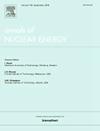Development and validation of fully-coupled subchannel analysis code for LMR within the MOOSE framework
IF 1.9
3区 工程技术
Q1 NUCLEAR SCIENCE & TECHNOLOGY
引用次数: 0
Abstract
As one of the Gen IV advanced reactors, liquid metal reactor (LMR) holds promising prospects for its high fuel efficiency and excellent inherent safety performance. Owing to its complex working conditions and ultra-high operating temperature, a thermal–hydraulic analysis of the reactor core is gradually playing a bigger role in recent years. Therefore, a subchannel code FLARE for LMRs has been developed within the Multiphysics Object-Oriented Simulation Environment (MOOSE) Framework, accompanied by the physical models tailored for LMRs embedded in FLARE.
Additionally, a hybrid discretization approach involving the Discontinuous Galerkin (DG) and Finite Element Method as well as the Jacobian-Free Newton-Krylov (JFNK) method are employed to solve the equations in a fully-coupled way. To validate the computational convergence of FLARE code under low flow rate conditions, the 7-pin experiment is adopted. The results exhibit that the absolute errors between the computed values and experimental data for the majority of calculation points are within 5 K. Furthermore, comparisons between the calculation values of FLARE (Fully-coupled transient code for Liquid-metal-cooled Advanced REactor), those of other programs and the experimental data are performed using 19-pin and 37-pin assembly experiments. The computational results indicate a good agreement between FLARE, experimental values, and other programs. In conclusion, FLARE code possesses the capability to accurately analyze the LMR core, which may provide new ideas for in-depth coupling research based on MOOSE.
求助全文
约1分钟内获得全文
求助全文
来源期刊

Annals of Nuclear Energy
工程技术-核科学技术
CiteScore
4.30
自引率
21.10%
发文量
632
审稿时长
7.3 months
期刊介绍:
Annals of Nuclear Energy provides an international medium for the communication of original research, ideas and developments in all areas of the field of nuclear energy science and technology. Its scope embraces nuclear fuel reserves, fuel cycles and cost, materials, processing, system and component technology (fission only), design and optimization, direct conversion of nuclear energy sources, environmental control, reactor physics, heat transfer and fluid dynamics, structural analysis, fuel management, future developments, nuclear fuel and safety, nuclear aerosol, neutron physics, computer technology (both software and hardware), risk assessment, radioactive waste disposal and reactor thermal hydraulics. Papers submitted to Annals need to demonstrate a clear link to nuclear power generation/nuclear engineering. Papers which deal with pure nuclear physics, pure health physics, imaging, or attenuation and shielding properties of concretes and various geological materials are not within the scope of the journal. Also, papers that deal with policy or economics are not within the scope of the journal.
 求助内容:
求助内容: 应助结果提醒方式:
应助结果提醒方式:


